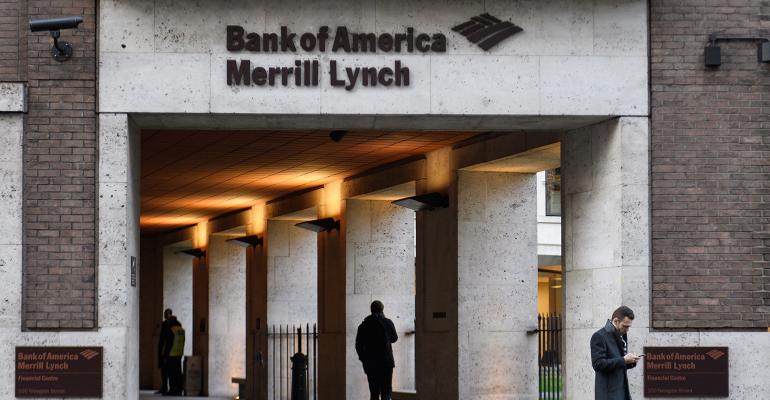Pay incentives and referrals in Bank of America’s wealth management unit were a boost to the bank’s second quarter earnings.
The bank’s Global Wealth and Investment Management group, which includes Merrill Lynch and U.S. Trust, posted record revenue of almost $9.6 billion through the first half of 2018, up 3 percent, or $278 million, from the first half of last year.
The unit’s revenue in the second quarter grew an anemic $14 million, or 0.3 percent, to $4.7 billion, bogged down by lower transactional revenue and net interest income, according to a statement from the company, slightly offset by growth of fees from fee-based accounts.
A Merrill Lynch executive familiar with the unit’s performance also attributed slower growth to a shift in how individual retirement accounts were advised during the second quarter in 2018 compared to last year, as the firm made adjustments to a potential Department of Labor’s Fiduciary rule, a rule which ultimately didn’t come to fruition. Meanwhile, while companies have benefited from the corporate tax break, high-net-worth clients living in high-tax states generally paid more, he said. Clients facing tax bills every spring typically position themselves to make payments, impacting their wealth managers.
Despite the slowdown, the wealth management unit reported that net income rose $163 million, up 20 percent, to nearly $1 billion, after taking into consideration the federal tax rate.
Tax implications aside, new pay incentives for the bank’s wealth managers and referrals between the GWIM unit and other units of the bank are delivering results.
In November of last year, Merrill Lynch released a new compensation plan for 2018 that offered an increased monthly payout to advisors by an additional 2 percent if they added clients and grew their net new assets and liabilities to a minimum of 5 percent, compared to the prior year-end total. In response, Merrill Lynch has added about 4.6 new households per advisor, up from about 2.4 in the second quarter of 2017. The brokerage hadn’t achieved that rate in at least 5 years.
Referrals to and from GWIM and other parts of Bank of America, such as commercial and investment banking, were also up 20 percent in the first half of 2018 compared to last year. Bank of America’s second quarter earnings report doesn’t detail referral activity between units. The GWIM executive could not share specific details of the referrals at the time.
Lending within wealth management continues to grow at a good clip. The unit’s loan balance grew for the 33rd straight quarter, and the average loan balance increased $10 billion, or 7 percent, to $161 billion in the second quarter. The growth was driven primarily by mortgage and structured lending offerings, which the GWIM executive said were either less competitive or unavailable entirely to Merrill Lynch clients before Bank of America bought the wealth manager. In wealth management, structured lending typically refers to customized loans using complex collateral, such as hedge fund positions, yachts, fine art or intellectual property. In the GWIM unit, that loan balance has grown from $33 billion a year ago to $39 billion in the second quarter of 2018.
Securities-based lending has shrunk slightly over the last year because of the interest rate environment, the GWIM executive added.
Bank of America reported net income of $6.8 billion, up 33 percent, and earning-per-share of 63 cents, up 43 percent, in the second quarter of 2018.

